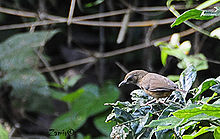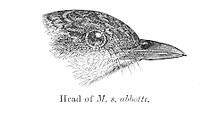- Abbott's Babbler
-
Abbott's Babbler 
In Shatchari, Sylhet, Bangladesh Conservation status Scientific classification Kingdom: Animalia Phylum: Chordata Class: Aves Order: Passeriformes Family: Timaliidae Genus: Malacocincla Species: M. abbotti Binomial name Malacocincla abbotti
Blyth, 1845Synonyms - Trichastoma abbotti
- Turdinus abbotti
Abbott's Babbler (Malacocincla abbotti) is a species of bird in the Timaliidae family. It is widely distributed along the Himalayas in South Asia and extending into the forests of Southeast Asia. They are short-tailed and stout birds which forage in pairs in dense undergrowth close to the ground and their presences is indicated by their distinctive calls.
Contents
Description
The adult Abbott's Babbler is a nondescript brown, short-tailed babbler that moves about in the low vegetation often near streams and in the vicinity of tree ferns and tangled vegetation. The throat is greyish white while the center of the belly is white and the flanks are olive. The undertail coverts are rusty. The sexes are alike. It has a short tail and heavy bill; it is drab olive-brown with bright rusty lower flanks and vent, a greyish-white throat and breast and variable pale grey supercilium and lores. Juvenile birds have dark rufescent-brown crowns and upperparts. The subspecies M. a. krishnarajui of the Eastern Ghats has a darker russet tail and rump than the Himalayan nominate subspecies. Specimens measure 12–13 cm (4.7–5.1 in) in length, with a head of 39–44 mm (1.5–1.7 in) and tail of 55–61 mm (2.2–2.4 in). The calls are distinctive.[2][3][4][5]
Taxonomy
The genus name Malacocincla is derived from the Ancient Greek malakos, meaning soft; combined with modern Latin cinclus, meaning thrush; referring to the birds' full and drooping plumage. The specific name abbotti was given by Edward Blyth after the specimen collector, Lieutenant Colonel J. R. Abbott (1811–1888) who served in British India as Assistant Commissioner of the Arakan in modern day Myanmar, from 1837 to 1845.[6] Blyth placed it in a new genus Malacocincla but subsequent workers placed it in Turdinus and Trichastoma. A revision reinstated its placement in Malacocincla in 1985 while a 2001 study confirmed the cohesiveness of the Trichastoma group.[7][8] An isolated population occurs in the Vishakapatnam Ghats, well separated from the nearest main distribution along the Himalayas and was named after Indian ornithologist K.S.R. Krishnaraju by Dillon Ripley and Bruce Beehler in 1985.[9] The nominate population is from southern Burma and extands to southern Tenasserim and northwestern Malaya including the Langkawi Islands. Several other populations of this widespread species have been named as subspecies and not all are recognized. The population in the eastern Himalayas from eastern Nepal to Sikkim and Assam was named as amabile but is now considered within the nominate subspecies. Others include alterum (=altera, central Laos and Annam), williamsoni (eastern Thailand and northwestern Cambodia), obscurius (= obscurior, coastal southeastern Thailand), olivaceum (Peninsular Thailand and Malaya), sirense (Borneo, Pulau Mata Siri) and baweanum (Bawean Island).[10]
Distribution and habitat
In South Asia, it is resident from Nepal to Arunachal Pradesh and the Assam Valley in India, south throughout the South Assam hills, including Meghalaya and south through the Lushai Hills. It is also resident in east and south Bangladesh, and the Eastern Ghats in North-east Andhra Pradesh and Orissa.[11] The altitudinal distribution is up to 600 m (2000 ft), 275 m (900 ft) in Nepal. It is widely distributed across Southeast Asia.[10]
It is common across much of its large range.[1] It is seen in the understory of broadleaved evergreen forest, forest edge, secondary growth and scrub. In Singapore, they have been noted as being tolerant to disturbance and adapting to secondary growth and disturbed forest.[12]
Behaviour and ecology
Abbott's Babbler usually moves around in pairs close to the ground. They breed from April to July (summer monsoon), with the nest being a carefully placed but bulky cup low in palms or other undergrowth. A study in Thailand found that most nests are placed in spiny palms and rattans.[13] The usual clutch is 3 to 5 eggs which are bright salmon with dark blotches and red lines. When disturbed at the nest, the bird slip over the edge and fly with laboured wing beats and then hop out of sight.[2][14] More than one brood may be raised in a season.[15]
Their distincitive calls consists of three or four notes with the a drop on the middle note. The antiphonal duet of a male and female has the male leading with a "poor'ol bear" followed by the females "dear dear". The tunes may however change over time.[16] The birds tend to remain within a well marked area and do not wander widely.[2] The song is a variable short series of around three to four notes of rich, fluty, liquid, slurred, short whistled notes; these are sometimes delivered haltingly and sometimes rapidly. The evening group song consists of a recurrent sputtering churrr sound, which is low and slurred; ending with a sharp chreep. Calls include soft mewing notes, and a pulsing, purring trill when agitated.[3]
References
- ^ a b BirdLife International (2008). Malacocincla abbotti. In: IUCN 2008. IUCN Red List of Threatened Species. Downloaded on 20 May 2011.
- ^ a b c Ali, S & S D Ripley (1996). Handbook of the Birds of India and Pakistan. Volume 6 (2 ed.). New Delhi: Oxford University Press. pp. 127–128.
- ^ a b Rasmussen PC & JC Anderton (2005). Birds of South Asia. The Ripley Guide. Volume 2. Smithsonian Institution and Lynx Edicions. p. 424.
- ^ Baker, ECS (1922). Fauna of British India. Birds. Volume 1 (2 ed.). London: Taylor and Francis. http://www.archive.org/stream/birds___01bake#page/260/mode/1up.
- ^ Oates, E W (1889). Blanford, WT. ed. The Fauna of British India. Birds. Volume 1. London: Taylor and Francis. p. i54. http://www.archive.org/stream/birdsindia01oaterich#page/154/mode/1up.
- ^ Jobling, James A (1992). A Dictionary of Scientific Bird Names. Oxford University Press. p. 1. ISBN 0198546343.
- ^ Ripley SD & BM Beehler (1985). "A revision of the babbler genus Trichastoma and its allies (Aves: Timaliinae)". Ibis 127 (4): 495–509. doi:10.1111/j.1474-919X.1985.tb04844.x.
- ^ Wells, D.R., P. Andrew & A.B. van den Berg (2001). "Systematic notes on Asian birds. 21. Babbler jungle: a reevaluation of the ‘pyrrogenys’ group of Asian pellorneines (Timaliidae).". Zool. Verh. Leiden 335: 235–254. http://www.repository.naturalis.nl/document/46460.
- ^ Ripley, S. D. and Beehler, B. M. (1985). "A new subspecies of the babbler genus Malacocincla abbotti from the Eastern. Ghats, India". Bull. Brit. Orn. Club 105 (2): 67. http://si-pddr.si.edu/dspace/bitstream/10088/12780/1/VZ_165_Cuban_bird_weights.pdf.
- ^ a b Mayr E & Paynter Jr., R A, ed (1964). Check-list of birds of the world. Volume 10. Cambridge, Massachusetts: Museum of Comparative Zoology. pp. 255–256. http://www.archive.org/stream/checklistofbirds101964pete#page/254/mode/1up.
- ^ Dasgupta, JM (1976). "Occurrence of Abbott's Babbler Trichastoma abbotti (Blyth) in Orissa". J. Bombay Nat. Hist. Soc. 73 (1): 217–218.
- ^ Yong, DL (2009). "Persistence of Babbler (Timaliidae) communites in Singapore forests". Nature in Singapore 2: 365–371. http://rmbr.nus.edu.sg/nis/bulletin2009/2009nis365-371.pdf.
- ^ Pobprasert, Korakoch & George A. Gale (2010). "Nest-Site Selection by Abbott's Babblers Malacocincla abbotti in Northeastern Thailand". Acta Ornithologica 45 (1): 67–74. doi:10.3161/000164510X516100.
- ^ Hume, AO (1889). Oates, EW. ed. The nests and eggs of Indian birds. Volume 1 (2 ed.). London: R.H.Porter. p. 103. http://www.archive.org/stream/nestseggsofindia01humerich#page/102/mode/1up.
- ^ Pierce, Andrew J.; Korakoch Pobprasert, George A. Gale (2004). "Breeding Ecology and Nesting Success of Abbott's Babbler (Malacocincla abbotti)". The Wilson Bulletin 116 (3): 275–277. doi:10.1676/04-010.
- ^ Fleming RL and M A Traylor (1968). "Distributional notes on Nepal birds". Fieldiana: Zoology 53 (3): 147–203. http://www.archive.org/stream/distributionalno533flem#page/194/mode/1up.
External links
Categories:- IUCN Red List least concern species
- Malacocincla
- Birds of Nepal
- Birds of India
- Birds of Bangladesh
- Animals described in 1845
Wikimedia Foundation. 2010.



